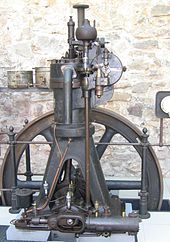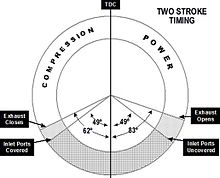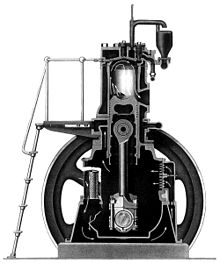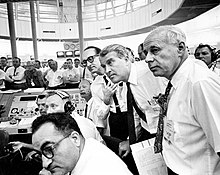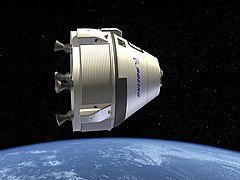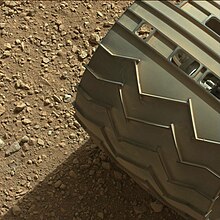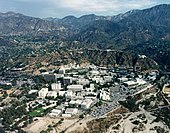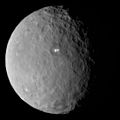Creation
From 1946, the
National Advisory Committee for Aeronautics (NACA) had been experimenting with rocket planes such as the supersonic
Bell X-1.
[17] In the early 1950s, there was challenge to launch an artificial satellite for the
International Geophysical Year (1957–58). An effort for this was the American
Project Vanguard. After the
Soviet launch of the world's first artificial
satellite (
Sputnik 1) on October 4, 1957, the attention of the United States turned toward its own fledgling space efforts. The
US Congress, alarmed by the perceived threat to national security and technological leadership (known as the "
Sputnik crisis"), urged immediate and swift action; President
Dwight D. Eisenhower and his advisers counseled more deliberate measures. On January 12, 1958, NACA organized a "Special Committee on Space Technology", headed by
Guyford Stever.
[12] On January 14, 1958, NACA Director
Hugh Dryden published "A National Research Program for Space Technology" stating:
[18]
It is of great urgency and importance to our country both from consideration of our prestige as a nation as well as military necessity that this challenge [
Sputnik] be met by an energetic program of research and development for the conquest of space... It is accordingly proposed that the scientific research be the responsibility of a national civilian agency... NACA is capable, by rapid extension and expansion of its effort, of providing leadership in
space technology.
[18]
While this new federal agency would conduct all non-military space activity, the
Advanced Research Projects Agency (ARPA) was created in February 1958 to develop space technology for military application.
[19]
On July 29, 1958, Eisenhower signed the
National Aeronautics and Space Act, establishing NASA. When it began operations on October 1, 1958, NASA absorbed the 43-year-old NACA intact; its 8,000 employees, an annual budget of US$100 million, three major research laboratories (
Langley Aeronautical Laboratory,
Ames Aeronautical Laboratory, and
Lewis Flight Propulsion Laboratory) and two small test facilities.
[20] A
NASA seal was approved by President Eisenhower in 1959.
[21] Elements of the
Army Ballistic Missile Agency and the
United States Naval Research Laboratory were incorporated into NASA. A significant contributor to NASA's entry into the
Space Race with the Soviet Union was the technology from the
German rocket program led by
Wernher von Braun, who was now working for the
Army Ballistic Missile Agency (ABMA), which in turn incorporated the technology of American scientist
Robert Goddard's earlier works.
[22] Earlier research efforts within the
US Air Force[20] and many of ARPA's early space programs were also transferred to NASA.
[23] In December 1958, NASA gained control of the
Jet Propulsion Laboratory, a contractor facility operated by the
California Institute of Technology.
[20]
Staff and leadership

Charles Bolden speaks after landing of the last Space Shuttle mission,
STS-135
The agency's leader,
NASA's administrator, is nominated by the
President of the United States subject to approval of the
US Senate, and reports to him or her and serves as senior space science advisor. Though space exploration is ostensibly non-partisan, the appointee usually is associated with the President's political party (
Democratic or
Republican), and a new administrator is usually chosen when the Presidency changes parties. The only exceptions to this have been:
James C. Fletcher, appointed by Republican
Richard Nixon but stayed through May 1977 into the term of Democrat
Jimmy Carter;
Daniel Goldin, appointed by Republican
George H. W. Bush and stayed through the administration of Democrat
Bill Clinton; and
Robert M. Lightfoot, Jr., associate administrator under Democrat
Barack Obama kept on as acting administrator by Republican
Donald Trump.
[6] Though the agency is independent, the survival or discontinuation of projects can depend directly on the will of the President.
[24]
The first administrator was Dr.
T. Keith Glennan appointed by Republican President
Dwight D. Eisenhower. During his term he brought together the disparate projects in American space development research.
[25]
The third administrator,
James E. Webb (1961–1968), appointed by President
John F. Kennedy, was a Democrat who first publicly served under President
Harry S. Truman. In order to implement the
Apollo program to achieve Kennedy's Moon landing goal by the end of the 1960s, Webb directed major management restructuring and facility expansion, establishing the Houston Manned Spacecraft (Johnson) Center and the Florida Launch Operations (Kennedy) Center. Capitalizing on Kennedy's legacy, President
Lyndon Johnson kept continuity with the Apollo program by keeping Webb on when he succeeded Kennedy in November 1963. But Webb resigned in October 1968 before Apollo achieved its goal, and Republican President
Richard M. Nixon replaced Webb with Republican
Thomas O. Paine.
NASA Advisory Council
Space flight programs
NASA has conducted many manned and unmanned spaceflight programs throughout its history. Unmanned programs launched the first American artificial
satellites into Earth orbit for scientific and
communications purposes, and sent scientific probes to explore the planets of the solar system, starting with
Venus and
Mars, and including "
grand tours" of the outer planets. Manned programs sent the first Americans into
low Earth orbit (LEO), won the
Space Race with the
Soviet Union by landing twelve men on the Moon from 1969 to 1972 in the
Apollo program, developed a semi-reusable LEO
Space Shuttle, and developed LEO
space station capability by itself and with the cooperation of several other nations including post-Soviet
Russia. Some missions include both manned and unmanned aspects, such as the Galileo probe, which was deployed by astronauts in Earth orbit before being sent unmanned to Jupiter.
Manned programs
The experimental
rocket-powered aircraft programs started by NACA were extended by NASA as support for manned spaceflight. This was followed by a one-man
space capsule program, and in turn by a two-man capsule program. Reacting to loss of national prestige and
security fears caused by early leads in space exploration by the
Soviet Union, in 1961 President
John F. Kennedy proposed the ambitious goal "of landing a man on the Moon by the end of [the 1960s], and returning him safely to the Earth." This goal was met in 1969 by the
Apollo program, and NASA planned even more ambitious activities leading to a
manned mission to Mars. However, reduction of the perceived threat and changing political priorities almost immediately caused the termination of most of these plans. NASA turned its attention to an Apollo-derived temporary space laboratory, and a semi-reusable Earth orbital shuttle. In the 1990s, funding was approved for NASA to develop a permanent Earth orbital
space station in cooperation with the international community, which now included the former rival, post-Soviet
Russia. To date, NASA has launched a total of 166 manned space missions on rockets, and thirteen
X-15 rocket flights above the
USAF definition of spaceflight altitude, 260,000 feet (80 km).
[31]
X-15 rocket plane (1959–1968)
The
X-15 was an NACA experimental rocket-powered
hypersonic research aircraft, developed in conjunction with the US Air Force and Navy. The design featured a slender fuselage with fairings along the side containing fuel and early computerized control systems.
[32]Requests for proposal were issued on December 30, 1954, for the airframe, and February 4, 1955, for the rocket engine. The airframe contract was awarded to
North American Aviation in November 1955, and the XLR30 engine contract was awarded to
Reaction Motors in 1956, and three planes were built. The X-15 was
drop-launched from the wing of one of two NASA
Boeing B-52 Stratofortresses,
NB52A tail number 52-003, and
NB52B, tail number 52-008 (known as the
Balls 8). Release took place at an altitude of about 45,000 feet (14 km) and a speed of about 500 miles per hour (805 km/h).
Twelve pilots were selected for the program from the Air Force, Navy, and NACA (later NASA). A total of 199 flights were made between 1959 and 1968, resulting in the
official world record for the highest speed ever reached by a manned powered aircraft (current as of 2014), and a maximum speed of Mach 6.72, 4,519 miles per hour (7,273 km/h).
[33] The altitude record for X-15 was 354,200 feet (107.96 km).
[34] Eight of the pilots were awarded Air Force
astronaut wings for flying above 260,000 feet (80 km), and two flights by
Joseph A. Walker exceeded 100 kilometers (330,000 ft), qualifying as spaceflight according to the
International Aeronautical Federation. The X-15 program employed mechanical techniques used in the later manned spaceflight programs, including
reaction control system jets for controlling the orientation of a spacecraft,
space suits, and horizon definition for navigation.
[34] The
reentry and landing data collected were valuable to NASA for designing the
Space Shuttle.
[32]
Project Mercury (1958–1963)

John Glenn on Friendship 7: first US orbital flight, 1962
Shortly after the
Space Race began, an early objective was to get a person into Earth orbit as soon as possible, therefore the simplest spacecraft that could be launched by existing rockets was favored. The US Air Force's
Man in Space Soonest program considered many manned spacecraft designs, ranging from rocket planes like the X-15, to small ballistic
space capsules.
[35] By 1958, the space plane concepts were eliminated in favor of the ballistic capsule.
[36]
When NASA was created that same year, the Air Force program was transferred to it and renamed
Project Mercury. The
first seven astronauts were selected among candidates from the Navy, Air Force and Marine test pilot programs. On May 5, 1961, astronaut
Alan Shepard became the first American in space aboard
Freedom 7, launched by a
Redstone booster on a 15-minute
ballistic (suborbital) flight.
[37] John Glenn became the first American to be launched into
orbit, by an
Atlas launch vehicle on February 20, 1962, aboard
Friendship 7.
[38] Glenn completed three orbits, after which three more orbital flights were made, culminating in
L. Gordon Cooper's 22-orbit flight
Faith 7, May 15–16, 1963.
[39]
Project Gemini (1961–1966)
Based on studies to grow the Mercury spacecraft capabilities to long-duration flights, developing
space rendezvous techniques, and precision Earth landing, Project Gemini was started as a two-man program in 1962 to overcome the Soviets' lead and to support the Apollo manned lunar landing program, adding
extravehicular activity (EVA) and
rendezvous and
docking to its objectives. The first manned Gemini flight,
Gemini 3, was flown by
Gus Grissom and
John Young on March 23, 1965.
[41] Nine missions followed in 1965 and 1966, demonstrating an endurance mission of nearly fourteen days, rendezvous, docking, and practical EVA, and gathering medical data on the effects of weightlessness on humans.
[42][43]
Under the direction of
Soviet Premier Nikita Khrushchev, the USSR competed with Gemini by converting their Vostok spacecraft into a two- or three-man
Voskhod. They succeeded in launching two manned flights before Gemini's first flight, achieving a three-cosmonaut flight in 1963 and the first EVA in 1964. After this, the program was canceled, and Gemini caught up while spacecraft designer
Sergei Korolev developed the
Soyuz spacecraft, their answer to Apollo.
Apollo program (1961–1972)
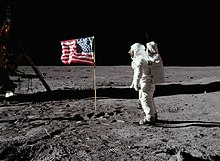
Apollo 11: Buzz Aldrin on the Moon, 1969.
The U.S public's perception of the Soviet lead in the space race (by putting the first man into space) motivated President
John F. Kennedy to ask the Congress on May 25, 1961, to commit the federal government to a program to land a man on the Moon by the end of the 1960s, which effectively launched the
Apollo program.
[44]
Apollo was one of the most expensive American scientific programs ever. It cost more than $20 billion in 1960s dollars
[45] or an estimated $208 billion in present-day US dollars.
[46] (In comparison, the
Manhattan Project cost roughly $26.6 billion, accounting for inflation.)
[46][47] It used the
Saturn rockets as launch vehicles, which were far bigger than the rockets built for previous projects.
[48] The spacecraft was also bigger; it had two main parts, the combined command and service module (CSM) and the lunar landing module (LM). The LM was to be left on the Moon and only the command module (CM) containing the three astronauts would eventually return to Earth.
The second manned mission,
Apollo 8, brought astronauts for the first time in a flight around the Moon in December 1968.
[49] Shortly before, the Soviets had sent an unmanned spacecraft around the Moon.
[50] On the next two missions docking maneuvers that were needed for the Moon landing were practiced
[51][52] and then finally the Moon landing was made on the
Apollo 11 mission in July 1969.
[53]
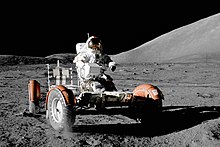
Apollo 17:
LRV-003, 1972.
The first
person to stand on the Moon was
Neil Armstrong, who was followed by
Buzz Aldrin, while
Michael Collins orbited above. Five subsequent Apollo missions also landed astronauts on the Moon, the last in December 1972. Throughout these six Apollo spaceflights, twelve men walked on the Moon. These missions returned a wealth of scientific data and 381.7 kilograms (842 lb) of lunar samples. Topics covered by experiments performed included
soil mechanics,
meteoroids,
seismology,
heat flow,
lunar ranging,
magnetic fields, and
solar wind.
[54] The Moon landing marked the end of the space race; and as a gesture, Armstrong mentioned mankind when he stepped down on the Moon.
[55]
Apollo set major
milestones in human spaceflight. It stands alone in sending manned missions beyond
low Earth orbit, and landing humans on another
celestial body.
[56] Apollo 8 was the first manned spacecraft to orbit another celestial body, while
Apollo 17 marked the last moonwalk and the last manned mission beyond
low Earth orbit to date. The program spurred advances in many areas of technology peripheral to rocketry and manned spaceflight, including
avionics, telecommunications, and computers. Apollo sparked interest in many fields of engineering and left many physical facilities and machines developed for the program as landmarks. Many objects and artifacts from the program are on display at various locations throughout the world, notably at the
Smithsonian's Air and Space Museums.
Skylab (1965–1979)

Skylab space station, 1974
Skylab was the United States' first and only independently built
space station.
[57] Conceived in 1965 as a workshop to be constructed in space from a spent
Saturn IB upper stage, the 169,950 lb (77,088 kg) station was constructed on Earth and launched on May 14, 1973, atop the first two stages of a
Saturn V, into a 235-nautical-mile (435 km) orbit inclined at 50° to the equator. Damaged during launch by the loss of its thermal protection and one electricity-generating solar panel, it was repaired to functionality by its first crew. It was occupied for a total of 171 days by 3 successive crews in 1973 and 1974.
[57] It included a laboratory for studying the effects of
microgravity, and a
solar observatory.
[57] NASA planned to have a Space Shuttle dock with it, and elevate Skylab to a higher safe altitude, but the Shuttle was not ready for flight before Skylab's re-entry on July 11, 1979.
[58]
To save cost, NASA used one of the Saturn V rockets originally earmarked for a canceled Apollo mission to launch the Skylab. Apollo spacecraft were used for transporting astronauts to and from the station. Three three-man crews stayed aboard the station for periods of 28, 59, and 84 days. Skylab's habitable volume was 11,290 cubic feet (320 m
3), which was 30.7 times bigger than that of the
Apollo Command Module.
[58]
Apollo–Soyuz Test Project (1972–1975)
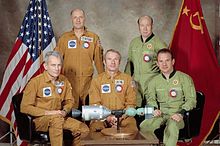
Soviet and American crews with spacecraft model, 1975.
On May 24, 1972, US President
Richard M. Nixon and
Soviet Premier
Alexei Kosygin signed an agreement calling for a joint manned space mission, and declaring intent for all future international manned spacecraft to be capable of docking with each other.
[59] This authorized the Apollo-Soyuz Test Project (ASTP), involving the rendezvous and docking in Earth orbit of a surplus
Apollo Command/Service Module with a
Soyuz spacecraft. The mission took place in July 1975. This was the last US manned space flight until the first orbital flight of the
Space Shuttle in April 1981.
[60]
The mission included both joint and separate scientific experiments, and provided useful engineering experience for future joint US–Russian space flights, such as the Shuttle–Mir Program
[61] and the International Space Station.
Space Shuttle program (1972–2011)

Launch of a Space Shuttle.

Mae Jemison working in Spacelab in 1992. Spacelab was a major NASA collaboration with Europe's space agencies
The
Space Shuttle became the major focus of NASA in the late 1970s and the 1980s. Planned as a frequently launchable and mostly reusable vehicle, four space shuttle orbiters were built by 1985. The first to launch,
Columbia, did so on April 12, 1981,
[62] the 20th anniversary of the first known human space flight.
[63]
Its major components were a
spaceplane orbiter with an external fuel tank and two solid-fuel launch rockets at its side. The external tank, which was bigger than the spacecraft itself, was the only major component that was not reused. The shuttle could orbit in altitudes of 185–643 km (115–400
miles)
[64] and carry a maximum payload (to low orbit) of 24,400 kg (54,000 lb).
[65] Missions could last from 5 to 17 days and crews could be from 2 to 8 astronauts.
[64]
In 1995, Russian-American interaction resumed with the
Shuttle–Mir missions (1995–1998). Once more an American vehicle docked with a Russian craft, this time a full-fledged space station. This cooperation has continued with Russia and the United States as two of the biggest partners in the largest space station built: the
International Space Station (ISS). The strength of their cooperation on this project was even more evident when NASA began relying on Russian launch vehicles to service the ISS during the two-year grounding of the shuttle fleet following the 2003
Space Shuttle Columbia disaster.
The Shuttle fleet lost two orbiters and 14 astronauts in two disasters:
Challenger in 1986, and
Columbia in 2003.
[68] While the 1986 loss was mitigated by building the
Space Shuttle Endeavour from replacement parts, NASA did not build another orbiter to replace the
second loss.
[68] NASA's Space Shuttle program had 135 missions when the program ended with the successful landing of the Space Shuttle
Atlantis at the Kennedy Space Center on July 21, 2011. The program spanned 30 years with over 300 astronauts sent into space.
[69]
International Space Station (1993–present)

The International Space Station as seen by the final STS mission
The
International Space Station (ISS) combines NASA's
Space Station Freedom project with the Soviet/Russian
Mir-2 station, the European
Columbus station, and the Japanese
Kibō laboratory module.
[70] NASA originally planned in the 1980s to develop
Freedom alone, but US budget constraints led to the merger of these projects into a single multi-national program in 1993, managed by NASA, the
Russian Federal Space Agency (RKA), the
Japan Aerospace Exploration Agency (JAXA), the
European Space Agency (ESA), and the
Canadian Space Agency (CSA).
[71][72] The station consists of pressurized modules, external
trusses,
solar arrays and other components, which have been launched by Russian
Proton and
Soyuz rockets, and the US Space Shuttles.
[70] It is
currently being assembled in
Low Earth Orbit. The on-orbit assembly began in 1998, the completion of the
US Orbital Segment occurred in 2011 and the completion of the
Russian Orbital Segment is expected by 2016.
[73][74][needs update] The ownership and use of the space station is established in intergovernmental treaties and agreements
[75] which divide the station into two areas and allow
Russia to retain full ownership of the Russian Orbital Segment (with the exception of Zarya),
[76][77] with the US Orbital Segment allocated between the other international partners.
[75]
Long duration missions to the ISS are referred to as
ISS Expeditions. Expedition crew members typically spend approximately six months on the ISS.
[78] The initial expedition crew size was three, temporarily decreased to two following the Columbia disaster. Since May 2009, expedition crew size has been six crew members.
[79] Crew size is expected to be increased to seven, the number the ISS was designed for, once the Commercial Crew Program becomes operational.
[80] The ISS has been continuously occupied for the past 17 years and 28 days, having exceeded the previous record held by
Mir; and has been visited by astronauts and cosmonauts from
15 different nations.
[81][82]
The station can be seen from the Earth with the naked eye and, as of 2017, is the largest artificial satellite in
Earth orbit with a mass and volume greater than that of any previous space station.
[83] The
Soyuz spacecraft delivers crew members, stays docked for their half-year-long missions and then returns them home. Several uncrewed cargo spacecraft service the ISS, they are the Russian
Progress spacecraft which has done so since 2000, the European
Automated Transfer Vehicle (ATV) since 2008, the Japanese
H-II Transfer Vehicle (HTV) since 2009, the American
Dragon spacecraft since 2012, and the American
Cygnus spacecraft since 2013. The Space Shuttle, before its retirement, was also used for cargo transfer and would often switch out expedition crew members, although it did not have the capability to remain docked for the duration of their stay. Until another US manned spacecraft is ready, crew members will travel to and from the International Space Station exclusively aboard the Soyuz.
[84] The highest number of people occupying the ISS has been thirteen; this occurred three times during the late Shuttle ISS assembly missions.
[85]
The ISS program is expected to continue until at least 2020, and may be extended beyond 2028.
[86]
Commercial Resupply Services (2006–present)
The Dragon is seen being berthed to the ISS in May 2012
The Standard variant of Cygnus is seen berthed to the ISS in September 2013
The development of the Commercial Resupply Services (CRS) vehicles began in 2006 with the purpose of creating American commercially operated uncrewed cargo vehicles to service the ISS.
[87] The development of these vehicles was under a fixed price milestone-based program, meaning that each company that received a funded award had a list of milestones with a dollar value attached to them that they didn't receive until after they had successful completed the milestone.
[88] Companies were also required to raise an unspecified amount of private investment for their proposal.
[89]
Commercial Crew Program (2010–present)
The
Commercial Crew Development (CCDev) program was initiated in 2010 with the purpose of creating American commercially operated crewed spacecraft capable of delivering at least four crew members to the ISS, staying docked for 180 days and then returning them back to Earth.
[95] It is hoped that these vehicles could also transport non-NASA customers to private space stations such those planned by
Bigelow Aerospace.
[96] Like COTS, CCDev is also a fixed price milestone-based developmental program that requires some private investment.
[88]
In 2010, NASA announced the winners of the first phase of the program, a total of $50 million was divided among five American companies to foster research and development into human spaceflight concepts and technologies in the private sector. In 2011, the winners of the second phase of the program were announced, $270 million was divided among four companies.
[97] In 2012, the winners of the third phase of the program were announced, NASA provided $1.1 billion divided among three companies to further develop their crew transportation systems.
[98] In 2014, the winners of the final round were announced.
[99] SpaceX's
Dragon V2 (planned to be launched on a
Falcon 9 v1.1) received a contract valued up to $2.6 billion and Boeing's
CST-100 (to be launched on an
Atlas V) received a contract valued up to $4.2 billion.
[100] NASA expects these vehicles to begin transporting humans to the ISS in 2017.
[100]
-
Computer rendering of CST-100 in orbit
Beyond Low Earth Orbit program (2010–present)

Artist's rendering of the 70 mt variant of SLS launching Orion
For missions beyond
low Earth orbit (BLEO), NASA has been directed to develop the
Space Launch System (SLS), a Saturn-V class rocket, and the two to six person, beyond low Earth orbit spacecraft,
Orion. In February 2010, President
Barack Obama's administration proposed eliminating public funds for the
Constellation program and shifting greater responsibility of servicing the ISS to private companies.
[101] During a speech at the Kennedy Space Center on April 15, 2010, Obama proposed a new heavy-lift vehicle (HLV) to replace the formerly planned
Ares V.
[102] In his speech, Obama called for a manned mission to an asteroid as soon as 2025, and a manned mission to Mars orbit by the mid-2030s.
[102] The
NASA Authorization Act of 2010 was passed by Congress and signed into law on October 11, 2010.
[103] The act officially canceled the Constellation program.
[103]
The Authorization Act required a newly designed HLV be chosen within 90 days of its passing; the launch vehicle was given the name "Space Launch System". The new law also required the construction of a beyond low earth orbit spacecraft.
[104] The
Orion spacecraft, which was being developed as part of the Constellation program, was chosen to fulfill this role.
[105] The Space Launch System is planned to launch both Orion and other necessary hardware for missions beyond low Earth orbit.
[106] The SLS is to be upgraded over time with more powerful versions. The initial capability of SLS is required to be able to lift 70 mt into
LEO. It is then planned to be upgraded to 105 mt and then eventually to 130 mt.
[105][107]
On June 5, 2016, NASA and DARPA announced plans to build a series of new X-planes over the next 10 years.
[108] One of the planes will reportedly be a supersonic vehicle that burns low-carbon
biofuels and generates quiet sonic booms.
[108]
Unmanned programs

Pioneer 3 and
4 launched in 1958 and 1959, respectively
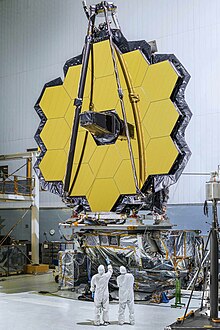
JWST main mirror assembled, November 2016
More than 1,000 unmanned missions have been designed to explore the Earth and the solar system.
[110] Besides exploration, communication satellites have also been launched by NASA.
[111] The missions have been launched directly from Earth or from orbiting space shuttles, which could either deploy the satellite itself, or with a rocket stage to take it farther.
The first US unmanned satellite was
Explorer 1, which started as an ABMA/JPL project during the early part of the
Space Race. It was launched in January 1958, two months after Sputnik. At the creation of NASA the Explorer project was transferred to this agency and still continues to this day. Its missions have been focusing on the Earth and the Sun, measuring magnetic fields and the
solar wind, among other aspects.
[112] A more recent Earth mission, not related to the Explorer program, was the
Hubble Space Telescope, which as mentioned above was brought into orbit in 1990.
[113]
The
inner Solar System has been made the goal of at least four unmanned programs. The first was
Mariner in the 1960s and '70s, which made multiple visits to
Venus and
Mars and one to
Mercury. Probes launched under the Mariner program were also the first to make a planetary flyby (
Mariner 2), to take the first pictures from another planet (
Mariner 4), the first planetary orbiter (
Mariner 9), and the first to make a
gravity assist maneuver (
Mariner 10). This is a technique where the satellite takes advantage of the gravity and velocity of planets to reach its destination.
[114]
Outside Mars, Jupiter was first visited by
Pioneer 10 in 1973. More than 20 years later
Galileo sent a probe into the planet's atmosphere, and became the first spacecraft to orbit the planet.
[116] Pioneer 11 became the first spacecraft to visit
Saturn in 1979, with
Voyager 2 making the first (and so far only) visits to
Uranus and
Neptune in 1986 and 1989, respectively. The first spacecraft to leave the solar system was
Pioneer 10 in 1983. For a time it was the most distant spacecraft, but it has since been surpassed by both
Voyager 1 and
Voyager 2.
[117]
Pioneers 10 and
11 and both Voyager probes carry messages from the Earth to extraterrestrial life.
[118][119] Communication can be difficult with deep space travel. For instance, it took about three hours for a radio signal to reach the
New Horizons spacecraft when it was more than halfway to Pluto.
[120] Contact with
Pioneer 10 was lost in 2003. Both Voyager probes continue to operate as they explore the outer boundary between the Solar System and interstellar space.
[121]
On November 26, 2011, NASA's
Mars Science Laboratory mission was successfully launched for Mars.
Curiosity successfully landed on Mars on August 6, 2012, and subsequently began its search for evidence of past or present life on Mars.
[122][123][124]
Recent and planned activities
NASA's ongoing investigations include in-depth surveys of Mars (
Mars 2020 and
InSight) and Saturn and studies of the Earth and the Sun. Other active spacecraft missions are
Juno for
Jupiter,
New Horizons (for Jupiter,
Pluto, and beyond), and
Dawn for the
asteroid belt. NASA continued to support
in situ exploration beyond the asteroid belt, including Pioneer and Voyager traverses into the unexplored trans-Pluto region, and
Gas Giant orbiters
Galileo (1989–2003),
Cassini(1997–2017), and
Juno (2011–).

Vision mission for an interstellar precursor spacecraft by NASA
On December 4, 2006, NASA announced it was planning a
permanent moon base.
[126] The goal was to start building the moon base by 2020, and by 2024, have a fully functional base that would allow for crew rotations and
in-situ resource utilization. However, in 2009, the
Augustine Committee found the program to be on an "unsustainable trajectory."
[127] In 2010, President
Barack Obama halted existing plans, including the Moon base, and directed a generic focus on manned missions to asteroids and Mars, as well as extending support for the International Space Station.
[128]
Since 2011, NASA's strategic goals have been
[129]
- Extend and sustain human activities across the solar system
- Expand scientific understanding of the Earth and the universe
- Create innovative new space technologies
- Advance aeronautics research
- Enable program and institutional capabilities to conduct NASA's aeronautics and space activities
- Share NASA with the public, educators, and students to provide opportunities to participate
On August 6, 2012, NASA landed the rover
Curiosity on Mars. On August 27, 2012,
Curiosity transmitted the first pre-recorded message from the surface of Mars back to Earth, made by Administrator Charlie Bolden:
Hello. This is Charlie Bolden, NASA Administrator, speaking to you via the broadcast capabilities of the Curiosity Rover, which is now on the surface of Mars.
Since the beginning of time, humankind’s curiosity has led us to constantly seek new life...new possibilities just beyond the horizon. I want to congratulate the men and women of our NASA family as well as our commercial and government partners around the world, for taking us a step beyond to Mars.
This is an extraordinary achievement. Landing a rover on Mars is not easy – others have tried – only America has fully succeeded. The investment we are making...the knowledge we hope to gain from our observation and analysis of Gale Crater, will tell us much about the possibility of life on Mars as well as the past and future possibilities for our own planet.
Curiosity will bring benefits to Earth and inspire a new generation of scientists and explorers, as it prepares the way for a human mission in the not too distant future. Thank you.
[134]
Scientific research

Radioisotope within a graphite shell that goes into the generator.
NASA started an annual competition in 2014 named
Cubes in Space.
[139] It is jointly organized by NASA and the global education company
I Doodle Learning, with the objective of teaching school students aged 11—18 to design and build scientific experiments to be launched into space on a NASA rocket or balloon. On June 21, 2017 the world's smallest satellite,
Kalam SAT, built by an Indian team, was launched.
[citation needed]
Climate study
NASA also researches and publishes on
climate issues.
[140] Its statements concur with the interpretation that the global climate is heating.
[141] Bob Walker, who has advised the 45th President of the United States
Donald Trump on space issues, has advocated that NASA should focus on space exploration and that its climate study operations should be transferred to other agencies such as
NOAA.
[142]
Facilities
John F. Kennedy Space Center (KSC), is one of the best-known NASA facilities. It has been the launch site for every United States human space flight since 1968. Although such flights are currently on pause, KSC continues to manage and operate unmanned rocket launch facilities for America's civilian space program from three pads at the adjoining Cape Canaveral Air Force Station.
The ten NASA field centers are:
- John F. Kennedy Space Center, Florida
- Ames Research Center, Moffett Field, California
- Armstrong Flight Research Center (formerly Hugh L. Dryden Flight Research Facility), Edwards, California
- Goddard Space Flight Center, Greenbelt, Maryland
- Jet Propulsion Laboratory, near Pasadena, California
- Lyndon B. Johnson Space Center, Houston, Texas
- Langley Research Center, Hampton, Virginia
- John H. Glenn Research Center, Cleveland, Ohio
- George C. Marshall Space Flight Center, Huntsville, Alabama
- John C. Stennis Space Center, Bay St. Louis, Mississippi
Budget
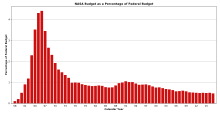
NASA's budget from 1958 to 2012 as a percentage of federal budget

An artist's conception, from NASA, of an astronaut planting a US flag on Mars. A
manned mission to Mars has been discussed as a possible NASA mission since the 1960s.
NASA's budget has generally been approximately 1% of the federal budget from the early 1970s on, after briefly peaking at approximately 4.41% in 1966 during the Apollo program.
[24][144] Public perception of NASA's budget has differed significantly from reality; a 1997 poll indicated that most Americans responded that 20% of the federal budget went to NASA.
[145]
The percentage of federal budget that NASA has been allocated has been steadily dropping since the Apollo program and in 2012 it was estimated at 0.48% of the federal budget.
[146] In a March 2012 meeting of the
United States Senate Science Committee,
Neil deGrasse Tyson testified that "Right now, NASA’s annual budget is half a penny on your tax dollar. For twice that—a penny on a dollar—we can transform the country from a sullen, dispirited nation, weary of economic struggle, to one where it has reclaimed its 20th century birthright to dream of tomorrow."
[147][148]
For Fiscal Year 2015, NASA received an appropriation of
US$18.01 billion from Congress—$549 million more than requested and approximately $350 million more than the 2014 NASA budget passed by Congress.
[149]
Environmental impact
The exhaust gases produced by rocket propulsion systems, both in Earth's atmosphere and in space, can adversely effect the Earth's environment. Some
hypergolic rocket propellants, such as
hydrazine, are highly toxic prior to
combustion, but decompose into less toxic compounds after burning. Rockets using hydrocarbon fuels, such as
kerosene, release carbon dioxide and soot in their exhaust.
[150]However, carbon dioxide emissions are insignificant compared to those from other sources; on average, the United States consumed 802,620,000 US gallons (3.0382
×10
9 L) gallons of liquid fuels per day in 2014, while a single
Falcon 9 rocket first stage burns around 25,000 US gallons (95,000 L) of
kerosene fuel per launch.
[151][152] Even if a Falcon 9 were launched every single day, it would only represent 0.006% of liquid fuel consumption (and carbon dioxide emissions) for that day. Additionally, the exhaust from
LOx- and
LH2- fueled engines, like the
SSME, is almost entirely water vapor.
[153] NASA addressed environmental concerns with its canceled
Constellation program in accordance with the National Environmental Policy Act in 2011.
[154]In contrast,
ion engines use harmless noble gases like
xenon for propulsion.
[155][156]
An example of NASA's environmental efforts is the
NASA Sustainability Base. Additionally, the Exploration Sciences Building was awarded the LEED Gold rating in 2010.
[158]
Observations
Plot of orbits of known Potentially Hazardous Asteroids (size over 460 feet (140 m) and passing within 4.7 million miles (7.6×106 km) of Earth's orbit)
Various nebulae observed from a NASA space telescope
-
-
Spacecraft
-
Cassini-Huygens, planned for disposal in 2017
Hubble Space Telescope, astronomy observatory in Earth orbit since 1990. Also visited by the Space Shuttle
Curiosity rover, roving Mars since 2012
Planned spacecraft
James Webb Space Telescope
Orion spacecraft design as of January 2013
Space Launch System concept art
Examples of missions by target
See also
















